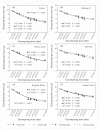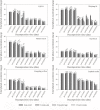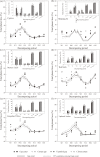Forest Gaps Alter the Total Phenol Dynamics in Decomposing Litter in an Alpine Fir Forest
- PMID: 26849120
- PMCID: PMC4746128
- DOI: 10.1371/journal.pone.0148426
Forest Gaps Alter the Total Phenol Dynamics in Decomposing Litter in an Alpine Fir Forest
Abstract
The total phenol content in decomposing litter not only acts as a crucial litter quality indicator, but is also closely related to litter humification due to its tight absorption to clay particles. However, limited attention has been focused on the total phenol dynamics in foliar litter in relation to forest gaps. Here, the foliar litter of six representative tree species was incubated on the forest floor from the gap center to the closed canopy of an alpine Minjiang fir (Abies faxoniana) forest in the upper reaches of the Yangtze River and eastern Tibetan Plateau. The dynamics of total phenol concentration in the incubated litter was measured from November 2012 to October 2014. Over two-year incubation, 78.22% to 94.06% of total phenols were lost from the foliar litter, but 52.08% to 86.41% of this occurred in the first year. Forest gaps accelerated the loss of total phenols in the foliar litter in the winter, although they inhibited the loss of total phenols during the growing season in the first year. In comparison with the effects of forest gaps, the variations of litter quality among different species were much stronger on the dynamics of total phenols in the second year. Overall, the loss of total phenols in the foliar litter was slightly higher in both the canopy gap and the expanded gap than in the gap center and under the closed canopy. The results suggest that the predicted decline in snow cover resulting from winter warming or vanishing gaps caused by forest regeneration will retard the loss of total phenol content in the foliar litter of alpine forest ecosystems, especially in the first decomposition year.
Conflict of interest statement
Figures





Similar articles
-
Forest Gaps Inhibit Foliar Litter Pb and Cd Release in Winter and Inhibit Pb and Cd Accumulation in Growing Season in an Alpine Forest.PLoS One. 2015 Jun 26;10(6):e0131528. doi: 10.1371/journal.pone.0131528. eCollection 2015. PLoS One. 2015. PMID: 26115012 Free PMC article.
-
Foliar litter nitrogen dynamics as affected by forest gap in the alpine forest of eastern Tibet Plateau.PLoS One. 2014 May 12;9(5):e97112. doi: 10.1371/journal.pone.0097112. eCollection 2014. PLoS One. 2014. PMID: 24820771 Free PMC article.
-
Gap locations influence the release of carbon, nitrogen and phosphorus in two shrub foliar litter in an alpine fir forest.Sci Rep. 2016 Feb 24;6:22014. doi: 10.1038/srep22014. Sci Rep. 2016. PMID: 26906762 Free PMC article.
-
Using experimental manipulation to assess the roles of leaf litter in the functioning of forest ecosystems.Biol Rev Camb Philos Soc. 2006 Feb;81(1):1-31. doi: 10.1017/S1464793105006846. Biol Rev Camb Philos Soc. 2006. PMID: 16460580 Review.
-
Influences of evergreen gymnosperm and deciduous angiosperm tree species on the functioning of temperate and boreal forests.Biol Rev Camb Philos Soc. 2015 May;90(2):444-66. doi: 10.1111/brv.12119. Epub 2014 Jun 11. Biol Rev Camb Philos Soc. 2015. PMID: 24916992 Review.
Cited by
-
Phenolic acid-degrading Paraburkholderia prime decomposition in forest soil.ISME Commun. 2021 Mar 25;1(1):4. doi: 10.1038/s43705-021-00009-z. ISME Commun. 2021. PMID: 36717596 Free PMC article.
-
Effects of naphthalene on soil fauna abundance and enzyme activity in the subalpine forest of western Sichuan, China.Sci Rep. 2019 Feb 26;9(1):2849. doi: 10.1038/s41598-019-39603-6. Sci Rep. 2019. PMID: 30809005 Free PMC article.
-
Deciphering the ecology of the threatened microendemic species Euphorbia margalidiana.Front Plant Sci. 2023 Jun 26;14:1155896. doi: 10.3389/fpls.2023.1155896. eCollection 2023. Front Plant Sci. 2023. PMID: 37434601 Free PMC article.
References
-
- Swift MJ, Heal OW, Anderson JM (1979) Decomposition in terrestrial ecosystems: Univ of California Press.
-
- Berg B, McClaugherty C (2008) Plant litter Berlin: Springer.
-
- Hättenschwiler S, Vitousek PM (2000) The role of polyphenols in terrestrial ecosystem nutrient cycling. Trends Ecol Evol 15: 238–243. - PubMed
-
- Balasundram N, Sundram K, Samman S (2006) Phenolic compounds in plants and agri-industrial by-products: antioxidant activity, occurrence, and potential uses. Food Chem 99: 191–203.
-
- Gallet C, Lebreton P (1995) Evolution of phenolic patterns in plants and associated litters and humus of a mountain forest ecosystem. Soil Biol Biochem 27: 157–165.
Publication types
MeSH terms
Substances
LinkOut - more resources
Full Text Sources
Other Literature Sources
Miscellaneous

